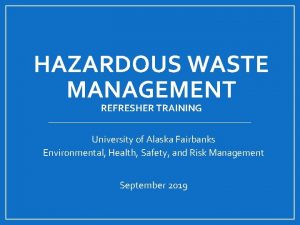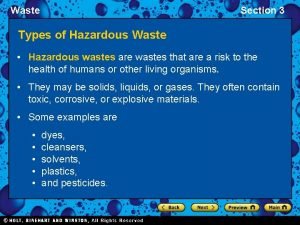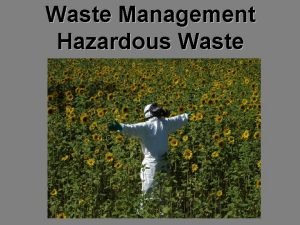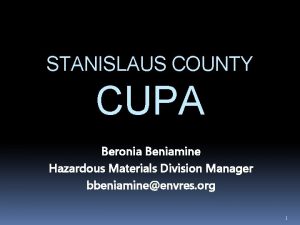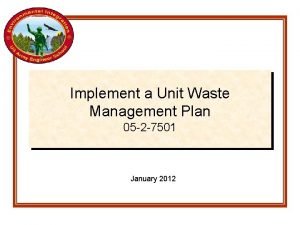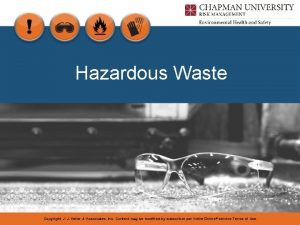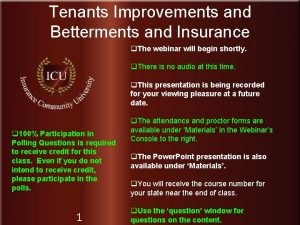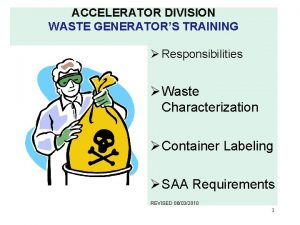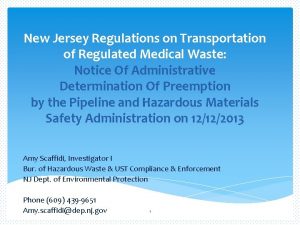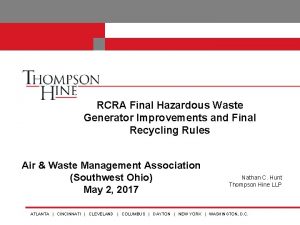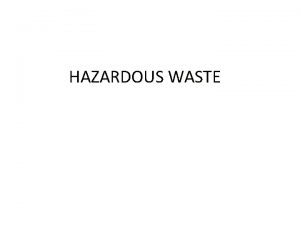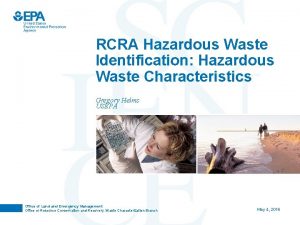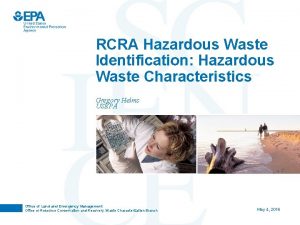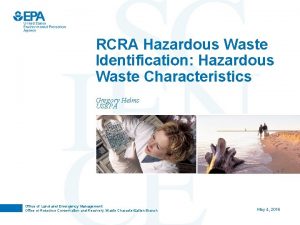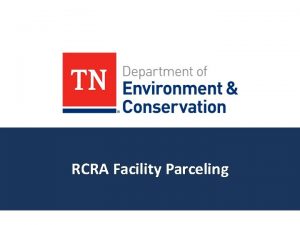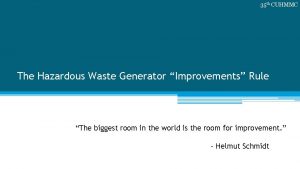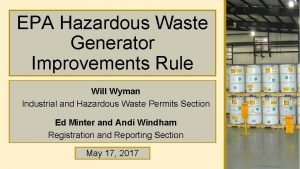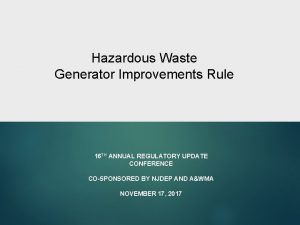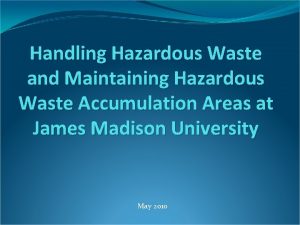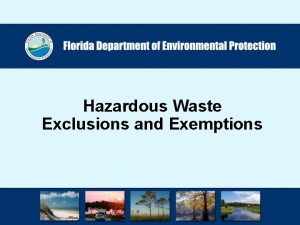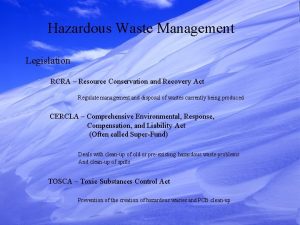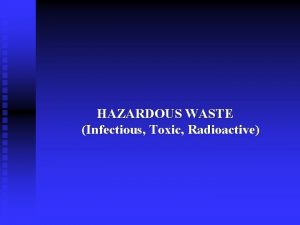RCRA Final Hazardous Waste Generator Improvements and Final














- Slides: 14

RCRA Final Hazardous Waste Generator Improvements and Final Recycling Rules Air & Waste Management Association (Southwest Ohio) May 2, 2017 Nathan C. Hunt Thompson Hine LLP ATLANTA | CINCINNATI | CLEVELAND | COLUMBUS | DAYTON | NEW YORK | WASHINGTON, D. C.

Hazardous Waste Generator Improvements Rule n Final Rule published in Federal Register on Nov. 28, 2016 (81 Fed. Reg. 85732) © Effective Date: May 30, 2017 n Some Major Changes: ¨ Generator Categories ¨ Episodic Events ¨ Waste Consolidation ¨ Labelling 2 2

Generator Categories n Hazardous waste generators are divided into three categories: Very Small Quantity Generator (“VSQG”) (replacing the prior Conditionally Exempt Small Quantity Generator (< 100 kg)) 3 Small Quantity Generator (“SQG”) (> 100 kg < 1000 kg) Large Quantity Generator (“LQG”) (> 1000 kg) 3

Generator Categories 1) VSQG and SQGs can maintain generator category if either planned or unplanned episodic event occurs that would otherwise bump Generator to more highly regulated category 2) VSQG may consolidate its hazardous waste into LQG facility with a common owner and operator 3) SQGs and LQGs have more rigorous container marking/labeling 4) SQGs and LQGs have more rigorous preparedness, prevention, planning, and emergency procedures for 5) Enhanced waste determination process 4 4

Planned or Unplanned Episodic Event 5 5

“Episodic” Generators Old Rule n Status of an CESQG, or LQG may vary month-to-month, depending on amount of hazardous waste generated in any month New Rule n Allows VSQGs and SQGs to maintain its usual status for a month in which episodic event occurs n Even if increase from an “episodic” event: © planned facility cleanout © spill and cleanup 6 6

Conditions for Maintaining Generator Status n VSQG or SQG limited to one episodic event per calendar year © May petition USEPA for a second episodic event but it cannot be the same type as the first episodic event ¨ if the first episodic event is planned, the second petitioned event must be unplanned or ¨ if the first event is unplanned, the second petitioned event must be planned n Must notify USEPA 30 days before planned episodic event using Form 8700 -12 n Must notify USEPA by phone, email, or fax within 72 hours of an unplanned episodic event (followed up with Form 8700 -12) 7 7

Conditions for Maintaining Generator Status n Notifications must include: © Start and end date © Reason(s) for event © Types and quantities of wastes generated © Facility contact and emergency coordinator n VSQG or SQG must have or obtain USEPA I. D. number 8 8

Conditions for Maintaining Generator Status n Episodic event waste must be in a container/tank marked with: © “Episodic Hazardous Waste” © Words identifying the contents that indicate the relevant hazards © Date on which episodic event started n VSQGs or SQGs must maintain records for 3 years from the end date of the episodic event © start and end dates n VSQG must manifest wastes to facility authorized to manage the wastes within 60 days of start of the episodic event © VSQG cannot treat waste on site except for in on-site elementary neutralization units n SQGs may treat the wastes onsite or manifest and ship waste off site within 60 days of start of the episodic event © reason(s)/description of episodic event © types and quantity of wastes © how wastes were managed & facility that received the wastes © name of transporter 9 9

Consolidating VSQG wastes into LQG 10 10

Consolidation of VSQG Wastes at LQG Sites 11 Old Rule New Rule n CESQGs must “ensure delivery” of their waste to an authorized facility n VSQGs may send wastes either to an authorized facility or to an LQG under the control of the same person 11

Consolidation of VSQG Wastes at LQG Sites n VSQG sending waste to an LQG must mark containers: © “Hazardous Waste” © with an indication of the hazards of the contents n The LQG receiving waste: © Must notify USEPA 30 days before receiving VSQG’s first shipment ¨ Submit Form 8700 -12 ¨ Must identify names, addresses, and contact information of VSGQs © Maintain records of shipments received for 3 years © Wastes must be specifically identified on biennial reporting forms 12 12

Rigorous SQG and LQG Labeling 13 13

Expanded Labeling/Marking of Containers Old Rule New Rule n SQGs and LQGs must label waste containers either: n Now, SQGs and LQGs must label containers with: ©“Hazardous Waste” or ©Words identifying the contents of the containers 14 ©“Hazardous Waste” and ©An indication of the hazards of the contents of the container 14
 Hazmat training alaska
Hazmat training alaska Solid and hazardous waste
Solid and hazardous waste Section 3 hazardous waste answers
Section 3 hazardous waste answers Color coding for waste disposal
Color coding for waste disposal E-waste definition apes
E-waste definition apes Sample of hazardous waste
Sample of hazardous waste Stanislaus county hazardous materials division
Stanislaus county hazardous materials division Segregation of hazardous waste
Segregation of hazardous waste Hazardous waste transportation
Hazardous waste transportation Famous human design reflectors
Famous human design reflectors Improvements & betterments
Improvements & betterments Medicare improvements for patients and providers act
Medicare improvements for patients and providers act Trashable cleaning products examples
Trashable cleaning products examples Nj medical waste tracking form
Nj medical waste tracking form Was invented by stephanie kwolek in 1966
Was invented by stephanie kwolek in 1966
